My friends, the game featured today is easily my favorite car racing game of all-time. I've always loved this game and it pained me to exclude it from my list of favorite games of all-time. If I had to remake the list then this game would probably replace my #5 title, Carmageddon. Hot Rod by Sega came out in 1988, the same year as Konami's Chequered Flag. Its graphics were simple sprites and lack of scaling made this game seem dated by comparison. The pace was slow and methodical and there wasn't much realism in the title to speak of. What Sega did get right, as the title suggests, was the spirit of the Hot Rod.
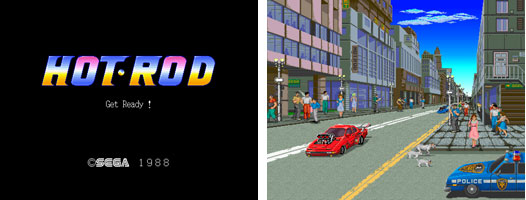
I mentioned back in the Monaco GP blog that Japan never went through a hot rod renaissance. They did not experience the D-I-Y car obsession that would influence their culture, at least not at the same time the US did. A driving culture shaped the US approach to arcade games while Japan went into the arcade arcade games with pro racing in mind. Some of Japan's better games happened when they got around to deconstructing the racer rather than emulating it. Sega was exceptional at being able to do both types of games.
Hot Rod was the ultimate boiled-down racing experience. It focused more on the drivers skill and ability to read a course than any other game. There was no gear shift and no brake pedal. Letting off the gas would stop the car. The steering wheel was loose like the Sprint games so that players could fling the car around corners. It was as pure a racing game as the arcade had ever seen. In a one player setting it was the ultimate challenge of man versus machine, against three human opponents it was a crazy fun time. Despite the name Hot Rod was a rally-type experience. It wasn't just a rally sim as it covered a lot of street racing as well. The tracks featured numerous surfaces and sometimes would have different patches in the middle of the course. From asphalt to snow, ice, sand and dirt. Each thing caused the cars to handle differently. Players had to stay on point and be able to drive with absolute precision.
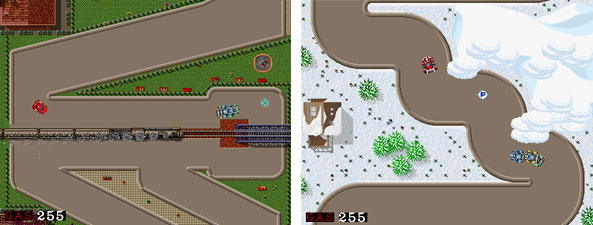
Everything that you would come to expect from a great racing game was featured here. The opponent AI were all skilled drivers but not perfect, they made mistakes from time to time, bumping into walls or blowing out their engines. Courses had shortcuts that could be exploited by daring drivers. These shortcuts were sometimes dangerous as they placed you on the path of an oncoming train, a slow moving bulldozer or even an avalanche. Knowing when and where to use these paths often meant the difference between winning and coming in last. The pace of the game was grinding, for some monotonous. It could sap the concentration of the gamer, leading to miniscule errors that would result in a game over screen. To truly get the most out of Hot Rod you had to be willing to go the distance. Players that did well were rewarded at the end of each third race by receiving a trophy and kiss from a girl.
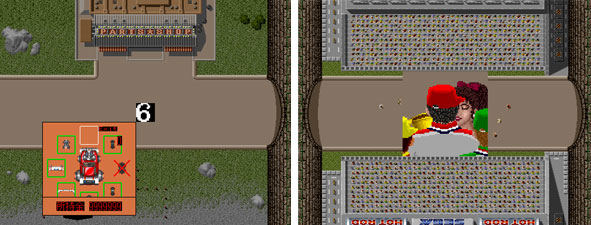
Hot Rod was also a cleverly balanced inventory control game. Players were rewarded cash amounts based on their finish. They could then take this prize money into a parts shop and buy an upgrade for their car. Unlike Super Sprint which limited the parts to three or four things, in Hot Rod there were five categories to keep track of and three levels of equipment in each category. Tires, wings, engines (front and rear) and bumpers, players had to learn how each effected their performance on the track and off road. AI opponents could also get upgrades along the way and keep pace with the player. Players had to learn which items to buy and in what order because no two part shops sold the same items. Sometimes the best strategy was to hold out for the next level to get better equipment. This left players underpowered so they had to work extra hard (and exploit all the right shortcuts) to come in first or second against the ruthless AI. These parts weren't guaranteed to last forever. Most engine upgrades would burn out at the end of the third race, as denoted by a backfire at the finish line.
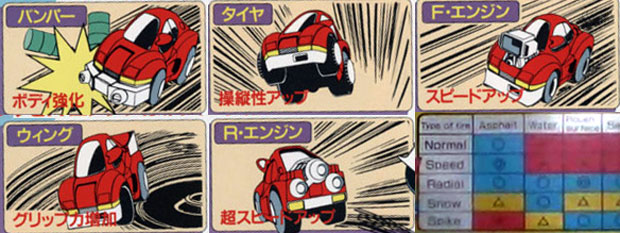
For an additional racing challenge Sega also added a gas tank to the cars. The gas would drop slowly but surely as the race progressed. Players could gain additional fuel by driving over "G" icons which would pop up intermittently on the course. There were also "P" icons for a score booster but these weren't as highly valued as fuel. The ranking at the end of each circuit would also determine how much gas you regained. If a player exploited every shortcut and drove over most of the G icons and came in first then they would get all of their fuel back. Players lost fuel if they crashed, fell off the road or were cut off as the screen advanced to the rest of the track. If the tank dropped below zero the game was over. Unfortunately the tank could never have a surplus of fuel. Casual gamers and seasoned players were experiencing racing on multiple levels.
The graphics in the courses all blended perfectly. Since the entire game was from overhead there was no sense of gradation or depth, any such cues had to be drawn onto the course as a series of shadows and objects. These imaginative two-dimensional courses were amazingly drawn. Sega had really outdone themselves in the art for this game. I especially liked the cabinet art and illustrations for the cars. The proportions of the cartoon hot rods were a blast. As if an animé designer were reinterpreting Dave Deal.

For a person like me obsessed with detail this game was an overdose. You could see tiny characters, made up of a few pixels, lining the courses and clapping. Children playing tag in the park or horsing around on the jungle gym. Couples walking down the promenade. Campers cooking over an open fire. Skiers descending from hills. The more you looked down on the tiny universe the more you would see. Of course you couldn't afford to take your eyes off the track for long or run the risk of losing. I'd be damned if I didn't fall in love with the absurd amount of details that populated each course.
If you thought I was crazy for the amount of time I invested in Stocker then you'd be ashamed to find out how obsessive I was with Hot Rod. To me it managed to capture the essence of racing better than Stocker, Super Sprint or any other racer combined. I had to be careful about where I played the game, dip switches and "turbo" kits ensured that the arcade and Sega were getting a return on their investment. Most arcades had the machines set in such a way that no matter how well you drove your car would run out of gas within two races. A four-player cabinet with no turbo kits and dip switches set to normal could actually be played forever. As I would eventually discover.
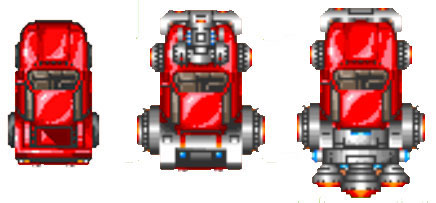
I would spend time studying each track layout, seeing what options were available in which part shops and what the ideal configuration was. I discovered that while the rear engine granted the most speed it also came at the cost of losing the rear wing so traction was lost on turns. If I purchased the most expensive speed tires and never switched them out then I would be able to hold my own on almost every track even without an engine upgrade. With the most expensive bumper then the life of my engine wouldn't suffer despite a crash. Before too long I had figured out the ideal setup and managed to get through every circuit with one quarter. What amazed me was that the tracks seemed interconnected transcontinental routes that circled the globe. The race managed one big loop and never really ended. It was a very imaginative innovation from Sega. For arcade owners it was a headache since kids like me were spending lots of time and not lots of money in their establishments.
My good friend Tim wondered how long I could spend on one quarter. I told him forever, or at least a day, provided that someone took over to give me a bathroom break. One summer, just after our first year in high school I went to the arcade early in the morning, right before they opened. The manager was wondering what I was up to. I told him that I planned on setting a new high score on the Hot Rod machine. He just nodded and let me into the empty arcade. I found a stool to sit on and put in my token. He would stop by occasionally to see the progress and ask if I really was on my original quarter. As the day wore on players would come and go. A few joined the game in progress and dropped out after a few laps. The manager and employees went from happy for me to slightly annoyed with my presence. Five hours later Tim stopped by so I could get my bathroom break and stretch my legs. I returned for another hour and a half of racing before calling it a day. I had amassed a fortune in the game and was wasting it buying different engines and tires. Even when I got the wrong components for the car I still managed to stay ahead of the competition. Finally I let my gas run out and put my name in the machine. It had a far more digits compared to the second and third place racers. Nobody would ever touch that score. While I had never reached California in Stocker I had gotten my revenge by doing laps around the globe in Hot Rod. As far as I was concerned I could die a happy man but then I would have missed out on so many other great games.
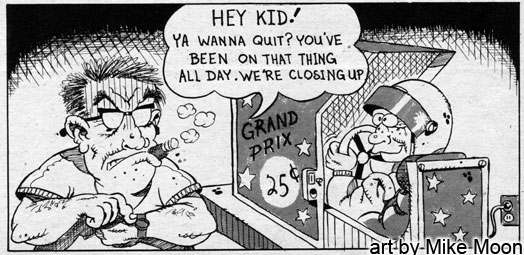
Come back next week to find out where the seeds for Japan's imaginative car games were planted.
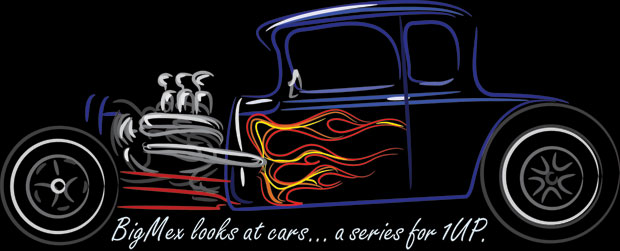

yes I played Hot Rod, but nowhere near as good as you! remembering all the upgrades made me wonder if there was a some kind of save system in place - I not sure if the game had one, but with all the stuff that you could amass it seemed like it could have benefitted from it.
ReplyDeletegame I could play (almost) forever Atari 2600 Asteroids i've probably mentioned this somewhere before in a comment or a blog granted it was not on a higher difficulty, but I started 1 night and ended 3 or 4 in the morning making the hi-score rollover (reset to zero) several times.
DaMan, I wish I had a good emulated version of Hot Rod, but it's not the same without the free spinning steering wheel. I was never good at Asteroids but I was a huge fan of Asteroids Deluxe and their screen layered with physical asteroids.
Delete